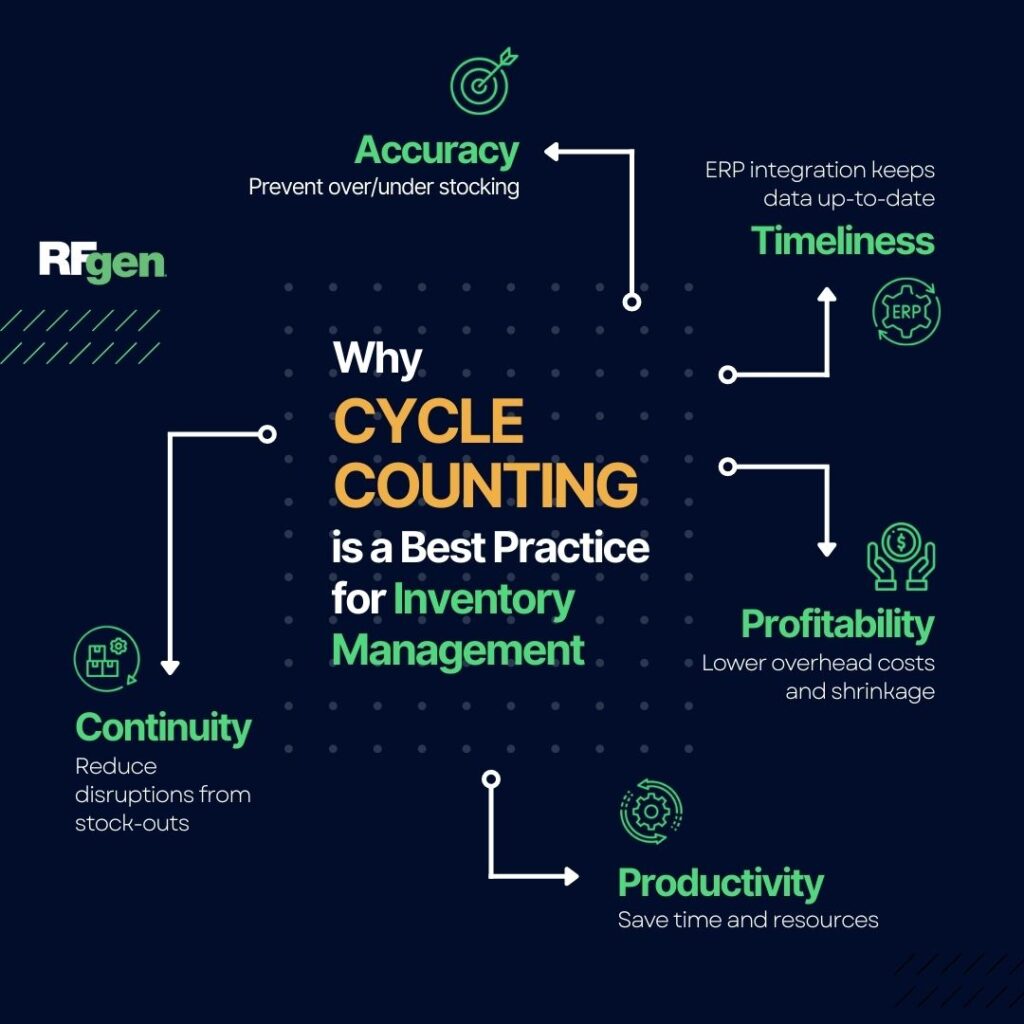Complete Guide to Inventory Cycle Counting Best Practices
- Inventory/Warehouse
- Cycle Counting
Overview
- Cycle counting is an essential best practice inventory control in the warehouse.
- Knowing how and when to perform cycle counts helps minimizes extra work.
- Technologies like mobile barcoding can transform cycle counting into a fast, efficient value-add.
If you handle inventory, then you’re familiar with counting items. Cycle counting is an efficient best practice to validate stock levels. It’s also a seemingly endless task, taking staff, time, and productivity away from valuable warehouse activities. So why do it?
Cycle counting re-affirms accuracy, making it a critical component of your warehouse hygiene. Maximum accuracy is needed to drive visibility, forecasting, and overall warehouse logistics, all of which impact the bottom line. An effective cycle counting strategy protects the availability of stock, prevents cost overruns, and ensures orders are delivered on time.
Meanwhile, wrong count levels hold back your entire inventory operation. Manual cycle counts do little to help. Digital transformation with mobile technology can change that, turning a perceived time-waster into a true value-add while drastically less effort.
Physical inventory counting vs cycle counting
There are two types of inventory counting: physical inventory counts and cycle counting.
Physical counting involves a comprehensive top-to-bottom counting of all inventory on-hand. Often, operations must halt while this occurs. The hands and effort required are high, as is the chance for error. In larger warehouses, performing physical counts more than once per year may not be feasible.
Cycle counting is a scaled-down, ongoing inventory audit. Businesses may use it as an alternative or in addition to physical counts. Though efficient and beneficial, the procedures can be complex and difficult to manage if done by hand. Automation software can greatly simplify the process and reduce operational burden.

Tips for Performing Physical Inventory Count Procedures
RELATED »
Purposes of cycle counting: accounting & operational efficiency
Cycle counting may seem like a drain on warehouse resources, but its value can’t be understated. Cycle counting inventory serves two primary purposes:
- Accurate Accounting
- Operational Efficiency
Accounting is only accurate if inventory counts are accurate and that data is kept up to date. Think of it like this: stock accuracy = accounting accuracy = business value.
Efficiency requires inventory best practices and the right tools to achieve it, such as mobile inventory software.
Cycle counting is an integral part of inventory control, ensuring stock levels are correct and operations don’t run into any barriers, like unexpected stock-outs or insufficient raw materials to fulfill a manufacturing order. Counts also help you identify areas for cost savings, such as undersells and deadstock.
Research shows that reducing stock-outs and excess inventory like safety stock can cut costs by 10%.

The Hidden Costs of Manual Cycle Counting
ALSO READ »Types of cycle counting
There are several cycle counting techniques. No one methodology will solve all inventory woes. Employed strategically, the right technique can prevent problems before they start.
The most common methods include:
ABC analysis (Pareto Principle Method)
ABC analysis cycle counting uses the Pareto Principle method to prioritize inventory into three tiers by the level of importance:
Category A items are your most important inventory. These are low-quantity, high-value items that move the fastest. Category A inventory should be counted most frequently. “A” stock is 20% of your inventory but accounts for 80% of sales.
Category B is second priority, containing mid-level quantity, value, speed, and counting frequency. “B” items may compose 30% of stock but 15% of sales.
Category C consists of high-quantity, low-value items with the lowest level of count priority. “C” materials can account for 50% of your total inventory but just 5% or less of sales.
Variants to this technique include usage-based ABC analysis and hybrid ABC analysis.
Process control cycling counting
In this technique, inventory counters perform cycle counts on SKUs with known discrepancies. Many businesses find process control group cycling both targeted and effective. Workers usually know where warehouse trouble spots are, so empowering them to solve accuracy issues with process control cycle counting can generate positive results.
Mobile inventory software can uncover additional inaccuracies in real-time, allowing managers to use analytics to target high-value areas.
Opportunity-based cycle counting
Opportunity-based cycle counting targets key checkpoints during inventory workflows. Checkpoints can be determined by setting decision parameters for certain processes, such as:
- Re-ordering
- Put away
- Replenishment
- Stock level dips below a designated threshold
With the aid of software, thresholds can automatically trigger alerts and assign tasks.
High-usage cycle counting
As with ABC analysis, in the high-usage methodology cycle counts are performed most frequently on inventory with the highest turns. Value is also a factor. Expensive inventory with rapid turnover takes the highest priority in this method.
Control group cycle counting
Using a control group as a reference point is informative. Cycle counting is no different. In this method, control groups are cycle counted multiple times over a specific period of time. Close scrutiny of a control group helps identify issues in counting methodology, as well as basics like stock levels, labels, ordering, and replenishment.
An inventory management system that performs cycle counts can eliminate many of these issues, especially those caused by manual processes.
Random cycle counting
Random cycle counting, also called “random sample cycle counting,” enables you to count a “sample” amount of a certain item type at random. The idea is that random checks periodically audit inventory control practices and stock levels without disrupting daily operations. Amazon is well-known for its random pick-and-putaway inventory system, which includes a form of random cycle counting.
A common variant, known as “diminished population counting,” involves excluding counted items from future cycle counts until the entire inventory has been validated.
How to conduct inventory counts
1. Develop a schedule
Planning is key to cycle counting effectiveness. Start by developing a regular schedule for counting inventory. Your schedule may include regular or daily cycle counts as well as an annual full physical inventory of the entire warehouse. Regardless of what technique(s) you use, it’s crucial to stick to the schedule and dedicate sufficient working hours to complete the task.
2. Preview inventory
Before jumping into cycle counting, organize your stock and check the current levels on-hand in your ERP system. This will save time and effort. If you’re using mobile apps for cycle counts, lookups for on-hand inventory are as simple as a quick barcode scan.
3. Pause warehouse activity
During a cycle count, no materials should be moved, picked, or restocked in that area of the warehouse. WIP transactions must be closed out. Otherwise, new inventory counts will be inaccurate or void. It may seem like a helpful shortcut to keep the warehouse running at maximum productivity while doing cycle counts, but in the end, it wastes more resources than it saves.
Mobile cycle counting apps can prevent changes to stock levels while drastically reducing operational pauses to a minimum.
4. Create an inventory count procedure
In addition to a schedule, you will need a clear process for exactly how and where cycle counts will be performed. The process should be shared with the warehouse team responsible for counts to avoid confusion or missteps. Include periodic feedback loops to identify areas for improvement in the counting process. Post the cycle count procedure where workers can see them. Consider adopting mobile barcoding software with built-in best practices for cycle counting the optimal results.

How to automate cycle counting for ERP
LEARN MORE »5. Set clear teams
Depending on the size of your warehouse, you may need to sort the inventory counters into dedicated teams. Two or three team members can cover more ground than one. Best practices also recommend alternating which staff does the counting. Special training may be required. Using mobile barcode scanners for cycle counts can help reduce training time, counting bias, and the number of staff needed.
6. Distribute count tags
Some operations use printed tags for cyclic counts. Assign or distribute tags to each inventory cycle counter to ensure all scheduled SKUs get touched. If you are using a double-counting method, then each tag should show two counts—the initial count by team A, and the recount by team B.
Certain ERP software systems like Oracle JD Edwards and Microsoft D365 have inventory tag counting baked-in to default functionality. Extending tag counting capabilities with mobile technology can make the process highly efficient and paper-free.
7. Count inventory
Now it’s time to count your inventory. Pair team members together so that one person physically counts items in a specific bin while a second record the values on the printed count tag. Workers will collect data points such as bin location, item name, item number, quantity, and size. Unexpected or mismatched results should be investigated and the issue corrected. Often, a simple recount solves the problem.
Regardless of what method you use, ensure counters are not distracted or pulled away for other tasks. Multi-tasking only increases the opportunity for mistakes and miscounts. Using mobile apps for inventory count procedures can greatly simplify the process.
8. Transfer count tag data
If you’re using printed count tags, recorded information must then be transferred to your inventory management system. For larger organizations, this is often an ERP platform. If your workers use mobile software that automates cycle counting procedures, then all relevant item data is collected at point-of-scan and transmitted to your ERP in real-time, bypassing this step entirely.
When to conduct an inventory cycle count
The best time to start a cycle count in the warehouse is outside normal operating hours, usually at the end of the day or before a new day begins. If your facility runs 24×7, put a system in place to separate newly received or picked inventory from materials being counted.
Timing may also be determined by other factors, such as:
- Why cycle counts are needed (e.g. inventory accuracy)
- How they will be executed
- Inventory value
- Inventory turnover
- Seasonal demand
- Warehouse layout
Just like cycle count methods, there are no right or wrong answers here. Each warehouse is different. Find what works for you.

Explore cycle counting resources
LEARN MORE »Challenges and risks of cycle counting
Every company faces challenges when it cycle counts inventory. Common challenges include:
- Staffing
- Coordinating multiple teams and/or locations
- Timeliness and inaccuracy of paperwork
- Accuracy of the cycle count process
If these sound familiar, you’re not alone. To increase your team’s skill in performing the counts, consider holding mock cycle counts and keeping an open feedback loop should other issues arise.
Many companies are also finding that fast, easy-to-use mobile apps for cycle counting alleviate these issues, driving productivity, speed, and accuracy without the need for paper.

Explore cycle counting software case studies
SUCCESS IN ACTION »Value of technology in cycle counting
Cycle counting is a value-add on its own. Technology can further enhance that added value, enabling you to manage inventory before it gets out of control. If cost is a worry, then research ROI. For example, mobile data collection typically pays for itself in 12 months or less.
Here are three ways technology assists with warehouse counting:
1. Data Management
Keeping data organized and free from error (“clean”) is important. Much of the heavy lifting is handled by inventory control software, WMS, or an ERP platform. However, each demands technical maintenance to keep multiple databases in sync. ERP mobility solutions can instead extend cycle counting capabilities to mobile devices, simplifying maintenance and complexity.
2. Mobile Scanners
High-speed mobile RF scanners are a game-changer for the inventory cycle count process. A millisecond barcode scan can replace minutes of work and update your ERP instantly. Such a cumulative productivity gain is also a money-saver compared to paper printouts, spreadsheets, or obsolete barcode software. On-demand mobile barcode printers and RFID solutions enable one employee to do the work of two.
3. Robot Counters
An exciting segment of robotic automation is emerging around next-gen Industry 4.0 devices. Helper co-bots, autonomous vehicles, and physical automation devices like scales, carousels, industrial computers, and IoT devices are capable of collecting valuable data. Integrating floor-level machines with data collection software is key to harvesting the latest advancements in counting technology. If you’re looking to take your inventory counts to the next level, robotics could be the answer.
Mobile cycle counting case studies
Discussing the theory of automated inventory counting is one thing. Seeing real-world results is another. The benefits of inventort cycle counting methods are numerous. Here are three case studies that illustrate the impact of effective inventory cycle count programs:
Mining company Alliances Resource Partners revolutionized its cycle count process flow by replacing paper printouts and data entry with fast scan-as-you-go mobile apps. The end result was 40% better inventory accuracy and significantly more efficient processes.
In another cycle count use case, global steel manufacturer NLMK USA performed daily cycle counts and reconciliation of inventory variances each night. Mobile barcoding helped cut labor time by 60% and increase accuracy to 100%.
Lastly, CryoLife’s cycle counting success story shows how automation and mobile offline inventory management software can work in the field. In this case, company representatives could use mobile barcode scanners to perform offline cycle counts on consignment inventory in hospitals. With no Wi-Fi or cellular coverage, the ability to digitally count products on-site and in their native language using a mobile device instead of paper checklists was a game-changer for traceability.
To read more about these cycle counting examples, visit the RFgen Resource Library
WATCH VIDEO: How to get world-class accuracy with automated cycle counting »
Cycle counting software
Cycle counting hardware is little help without the right software. The modern warehouse needs powerful tools to fight labor shortages and inefficiencies. Failure to adopt cycle counting technology can hurt your productivity and revenue. Even old barcode software is little better than performing inventory counts by hand.
Look to mobile inventory solutions that go beyond basic cycle counting mobile apps to streamline every facet of material handling. Mobile barcoding can enhance cycle counts for inventory without disrupting operations, and even augment your warehouse with offline cycle counting.
Cycle counting isn’t going anywhere. The question isn’t whether you will digitally transform or not. The question is when.
FAQs
1. How does cycle counting improve inventory accuracy compared to full physical counts?
Cycle counting inventory offers continuous checks on stock levels, reducing the risk of inaccurate counts that occur with a full physical inventory count. By addressing inventory discrepancies in real time, this method helps improve inventory accuracy without halting warehouse operations.
2. What role does technology play in enhancing cycle counting procedures?
Inventory management software and mobile devices simplify cycle counting procedures by automating data entry and minimizing human error. This integration speeds up counting inventory while increasing counting frequency, ensuring inventory control software keeps your entire inventory up to date.
3. How can cycle counting reduce inventory variance and improve cost savings?
By targeting high-value items and areas with known inventory errors, a cycle counting program helps reduce inventory variance. Techniques like abc analysis and diminished population counting enable businesses to optimize their inventory management strategy, preventing overstocking or stock-outs and resulting in significant cost savings.
4. What are the benefits of using control group cycle counting over random cycle methods?
Control group cycle counting allows you to monitor inventory items repeatedly to detect inventory discrepancies and refine counting techniques. While random cycle counts provide broad insights, control groups focus on specific areas, ensuring consistent accuracy and reinforcing best practices in warehouse counting.
5. How does counting frequency vary with abc cycle counting methods?
The abc counting method categorizes inventory into tiers, ensuring counting resources are allocated based on priority. Category A, consisting of high-value items, is counted more frequently, while lower-tier inventory levels undergo less frequent cycle counting, balancing effort and efficiency to manage inventory effectively.






